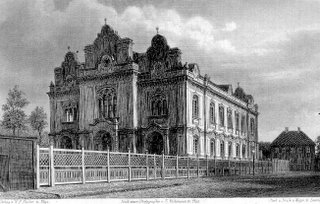Restoration Completed On Latvia's Sole Surviving Pre-War Synagogue
"RIGA - In 1904, a small group of wealthy Jewish merchants fought a maze of rules to open a synagogue in Peitavas Street in Riga’s Old Town. It would be far from the Moscow District where they lived, but close to the shops and markets where they worked. In Czarist Russia, synagogues were prohibited from being built too close to churches, so they had to get permission from the pastor of a Reform Church with which it would share the block.
The German architect Wilhelm Neumann (who had also been responsible for the striking [Riga] Museum of Fine Arts), a follower of the Jugendstil school, had been contracted and a total of 150,000 rubles had been spent. Finally, in the days before Rosh Hoshannah, they had gotten everything ready when the local government decided to forbid the synagogue’s opening.
A meeting between the wealthy benefactors of the synagogue and a local governor followed. An article in a Yiddish newspaper from the 1930s recounts a key speech:
"Young people are being led astray by the revolutionary movement. And with each day, the movement’s influence is stronger and stronger. So in order to restrain young people from these ideas, we decided to build a beautiful synagogue."
The answer, perhaps goaded by fears of the incipient threat of 1905: “Go and pray.” ...
Forty years later, it was the only synagogue among hundreds in the country to survive World War II. An obscure Psalm was written atop the marble alter, "Blessed art you the good, for you did not allow teeth to tear me," to remember the 80,000 to 100,000 Latvian Jews who did not." ...
Paul Morton "Riga Synagogue sees new life ahead" February 22, 2006. www.BalticTimes.com

Riga, Latvia's 1905 German-architect designed Synagogue.
Photo credit: http://www.roots-saknes.lv/Ethnicities/Jews/Texts/Synagogue.jpg
The German architect Wilhelm Neumann (who had also been responsible for the striking [Riga] Museum of Fine Arts), a follower of the Jugendstil school, had been contracted and a total of 150,000 rubles had been spent. Finally, in the days before Rosh Hoshannah, they had gotten everything ready when the local government decided to forbid the synagogue’s opening.
A meeting between the wealthy benefactors of the synagogue and a local governor followed. An article in a Yiddish newspaper from the 1930s recounts a key speech:
"Young people are being led astray by the revolutionary movement. And with each day, the movement’s influence is stronger and stronger. So in order to restrain young people from these ideas, we decided to build a beautiful synagogue."
The answer, perhaps goaded by fears of the incipient threat of 1905: “Go and pray.” ...
Forty years later, it was the only synagogue among hundreds in the country to survive World War II. An obscure Psalm was written atop the marble alter, "Blessed art you the good, for you did not allow teeth to tear me," to remember the 80,000 to 100,000 Latvian Jews who did not." ...
Paul Morton "Riga Synagogue sees new life ahead" February 22, 2006. www.BalticTimes.com

Riga, Latvia's 1905 German-architect designed Synagogue.
Photo credit: http://www.roots-saknes.lv/Ethnicities/Jews/Texts/Synagogue.jpg


0 Comments:
Post a Comment
<< Home